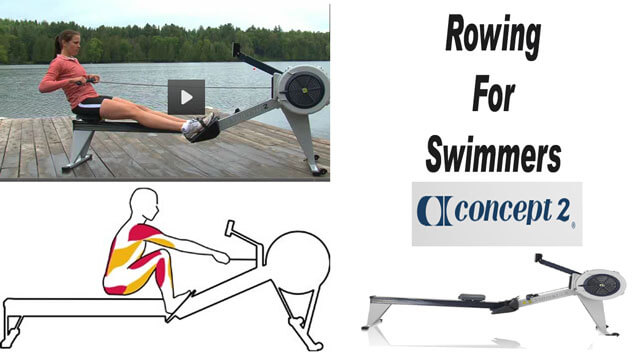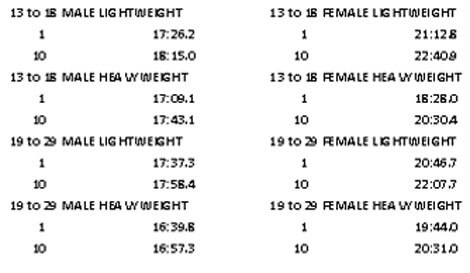Using the Concept2 Rowing Machine in Swimming Training

Guest editorial by Jack Simon, American Swimming Coaches of America Hall of Fame member, Past President of ASCA
PHOENIX, Arizona, April 17. LET me start by thanking Coach John Mason for introducing me to Concept2 Rowing way back in 1990. Off and on, where the opportunity presented itself, I found I really loved this form of exercise. However, not until I moved to Jalisco, Mexico, to take over their state program did I find the opportunity to have my swimming athletes take this up.
Not long after arrival one of my assistants informed me that there was a Concept2 Gym in Guadalajara designed for only rowing. We quickly made arrangements for my group of 19 swimmers (there were 19 rowing machines) to use the gym three times a week for one hour. Day one was working in the EN2 zone: 10 x 5 min. row with 1 min. rest. Day two working in EN3 zone: 12 x 3 min. rows with 2 min. rest. Day three was a power day: 5 x 500 meters with 4 minutes rest. All times and distances were logged.
The C2 is the machine that all the top rowers in the world train on during cold weather. So, you are competing against the best! My experience is that swimmers will do very well.
After three weeks we tested a 5000-meter row which we did on day three. All our swimmers were registered with Concept2 and I found almost all our athletes were in the top 10 in the world in their age group. Several went on to lead the world in both 5K and 10K.
Jalisco went on to win several national championships and national games (Olimpiada) during my tenure and I credit at least some of that to our training on the C2. Years later I went to Jiangsu province in China to take over their Institute of Sport swimming program, and one of the stipulations I made was I needed at least three C2 rowers. We started our rowing program for three days a week right after my arrival.
Again, all athletes were registered with Concept2 and we quickly found the same result. This time all our swimmers were in the top 10 in the world within their age group. Several of these athletes ended up top 15 in the world in their swimming events.
But what does this have to do with swimming? I’ll explain more about the physiology part of rowing later, but for now let’s stick with the technical part.
Rowing does the following: teaches an early catch, teaches hand speed, teaches feel, teaches a relaxed recovery, teaches pace at various speeds and it teaches negative splitting. I think you’ll agree that sounds a little bit like swimming! One of the great challenges on the C2 is trying to go 10 pulls at the same stroke rate and hold the same 500-meter pace time. I have yet to see anyone, including myself, get beyond eight pulls. In fact, if you can stay within one you’re doing extremely well. An example of that would be 10 pulls at 25 strokes per minute at 2:10 pace. If you can do that, imagine what the athlete learns about feel and pace.
Equipment: Your body, your mind and a pair of gloves! Much cheaper than golf!
Go online to the Concept2 website and you can see the description and pictures.
How you train on the C2, just as in the water, will determine what heart rate zone you are in. I’ve found that most of the athletes will stay in the 150 heart rate range when doing a long row of 30 minutes or more. However, if you want to really get your heart rate up, here are a few sets.
For your sprint people: 10 x 1 minute row with two minutes rest and stay at 38 to 42 strokes per minute. They will be begging for more rest after three or four and their heart rates will be very close to maximum.
Here’s an EN3 type set: 3 x 1000 meters with three minutes rest. Total work load will be about 13 to 15 minutes. Naturally, using a heart rate monitor will help determine what you are doing. With a new D model and PM4, you will receive a Garmin Chest belt and have wireless heart rate monitoring. Also, I would suggest that each swimmer have a log card. You can get this from any C2 distributor.
On the Concept2 site you will find a video to show correct technique. Overall, it’s pretty good, but one thing I would suggest that is contrary to the video is to keep the recovery on the same line as the pull. The rowers will dip their hands on the recovery to simulate bringing the oars over the water. As we are not training for rowing, I think by staying on the same line you will get a better and earlier catch.
Early on in your training I would recommend a lot of Fartlek (speed play in Swedish) training. An example might be five minutes of warm up, then three minutes fast row at 30 strokes per minute, two minutes moderate row at 23/24 strokes per minute for 30 minutes. Always try to bring the 500 pace down (negative splitting) as you go through the set. An example might be 2:25 at the beginning and bring that down to 1:50 by the end of the bout.
A set that Shannon McIntyre (former national breaststroke finalist back in 1982 and now married to Coach Ray Woods) likes is an hour of power. Row hard until you reach maximum heart rate, then slow down until your heart rate reaches 40 beats per minute, then start over again. Count and log how many strokes it takes for your heart rate to come down to the prescribed level. Continue that for one hour. Shannon is now one of the top rowers in the nation at almost 50 years old. Her best 2000 meters is 7:05.
Below I have listed for both lightweight and heavyweight the first and tenth times in the world for a 5000-meter row as of this writing. You can find the weight rules on the Concept2 site. Very easy registration, and you can also register your team to row in various competitions.

There is no cost involved. The rankings are great motivation for the athletes. Just like placing the great sets on your bulletin board, keep the rankings and how your swimmer are doing in front of them. While I’m not into guaranteeing, I would be very surprised that after rowing three days a week for three weeks that you would not see a real improvement in the pool.
Some other workout suggestions: 10 x 500 with 1 minute rest, but the total time must be at least one minute faster than a straight 5K row.
Do a one hour row, coming down each 5 minutes.
20 x 2 minutes w/30 seconds rest.
Row a 10,000 for time.
You can create hundreds of different variables, so let your imagination run wild! Best of luck and feel free to let me know how you’re doing on the C2 at: jsimon7946@gmail.com.



